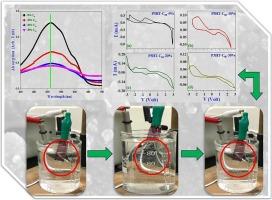Concentration driven changes in structural, optical, and electrochemical properties of spin coated poly 3-hexylthiophene (P3HT) thin films via fullerene (C60) incorporation
IF 4.6
3区 材料科学
Q2 MATERIALS SCIENCE, MULTIDISCIPLINARY
引用次数: 0
Abstract
Surface morphology plays a decisive role in thin films' optical and electrical properties. This can be precisely tuned through chemical modifications (interstitial or substitutional doping) and/or sample annealing. This study investigated the effect of fullerene (C60) on the optical and electrochromic characteristics of spin-coated P3HT thin films for various concentration levels. Structural and morphological analysis revealed enhanced crystallite size (from 10 nm to 25 nm) and particle aggregation with increasing C60 concentration. This surface modification significantly influenced the optical and electrochromic characteristics of the films. With the increase in C60 concentration, (1) the optical band gap decreased from 2.50 eV to 1.92 eV, (2) peak intensity in UV–vis. and in PL spectra were quenched, and (3) the optical contrast decreased from 60 % to 8 %. The increment in the C60 concentration influences the oxidation and reduction pathways as observed in the CV spectra. It is observed that the C60 concentration influenced the cathode current diffusion coefficient more than that of the anode current diffusion coefficient. However, these higher C60 concentration films still showed an electrochromic response.

富勒烯(C60)掺入对自旋涂覆聚3-己基噻吩(P3HT)薄膜结构、光学和电化学性能的影响
表面形貌对薄膜的光学和电学性能起着决定性的作用。这可以通过化学修饰(间隙或取代掺杂)和/或样品退火来精确调整。本文研究了不同浓度富勒烯(C60)对自旋涂覆P3HT薄膜光学和电致变色特性的影响。结构和形态分析表明,随着C60浓度的增加,晶体尺寸增大(从10 nm增加到25 nm),颗粒聚集性增强。这种表面修饰显著地影响了薄膜的光学和电致变色特性。随着C60浓度的增加,(1)光学带隙从2.50 eV减小到1.92 eV;(2)紫外可见峰强度。(3)光学对比度从60%下降到8%。在CV光谱中观察到,C60浓度的增加会影响氧化和还原途径。观察到C60浓度对阴极电流扩散系数的影响大于对阳极电流扩散系数的影响。然而,这些C60浓度较高的薄膜仍然表现出电致变色反应。
本文章由计算机程序翻译,如有差异,请以英文原文为准。
求助全文
约1分钟内获得全文
求助全文
来源期刊

Materials Science and Engineering: B
工程技术-材料科学:综合
CiteScore
5.60
自引率
2.80%
发文量
481
审稿时长
3.5 months
期刊介绍:
The journal provides an international medium for the publication of theoretical and experimental studies and reviews related to the electronic, electrochemical, ionic, magnetic, optical, and biosensing properties of solid state materials in bulk, thin film and particulate forms. Papers dealing with synthesis, processing, characterization, structure, physical properties and computational aspects of nano-crystalline, crystalline, amorphous and glassy forms of ceramics, semiconductors, layered insertion compounds, low-dimensional compounds and systems, fast-ion conductors, polymers and dielectrics are viewed as suitable for publication. Articles focused on nano-structured aspects of these advanced solid-state materials will also be considered suitable.
 求助内容:
求助内容: 应助结果提醒方式:
应助结果提醒方式:


